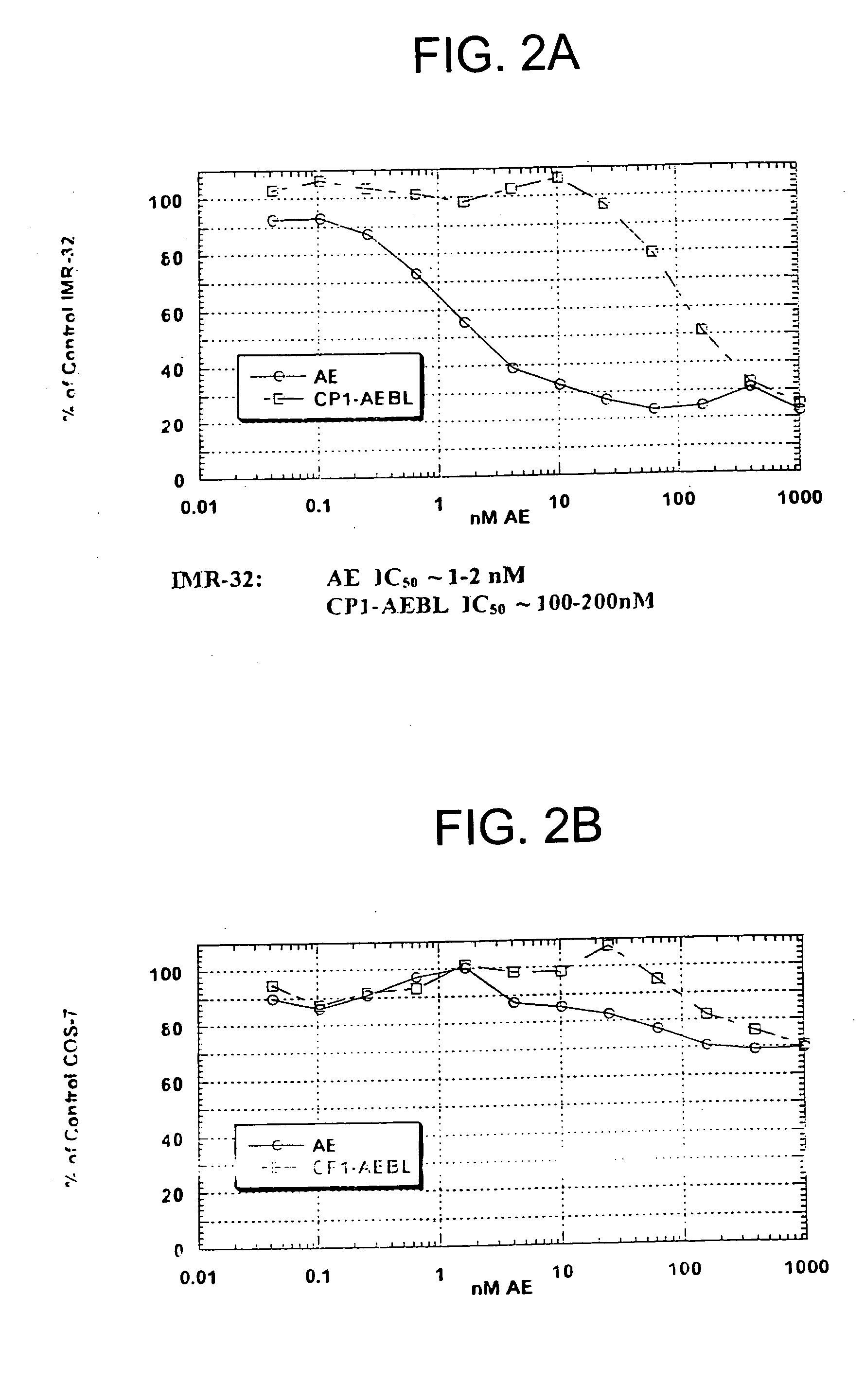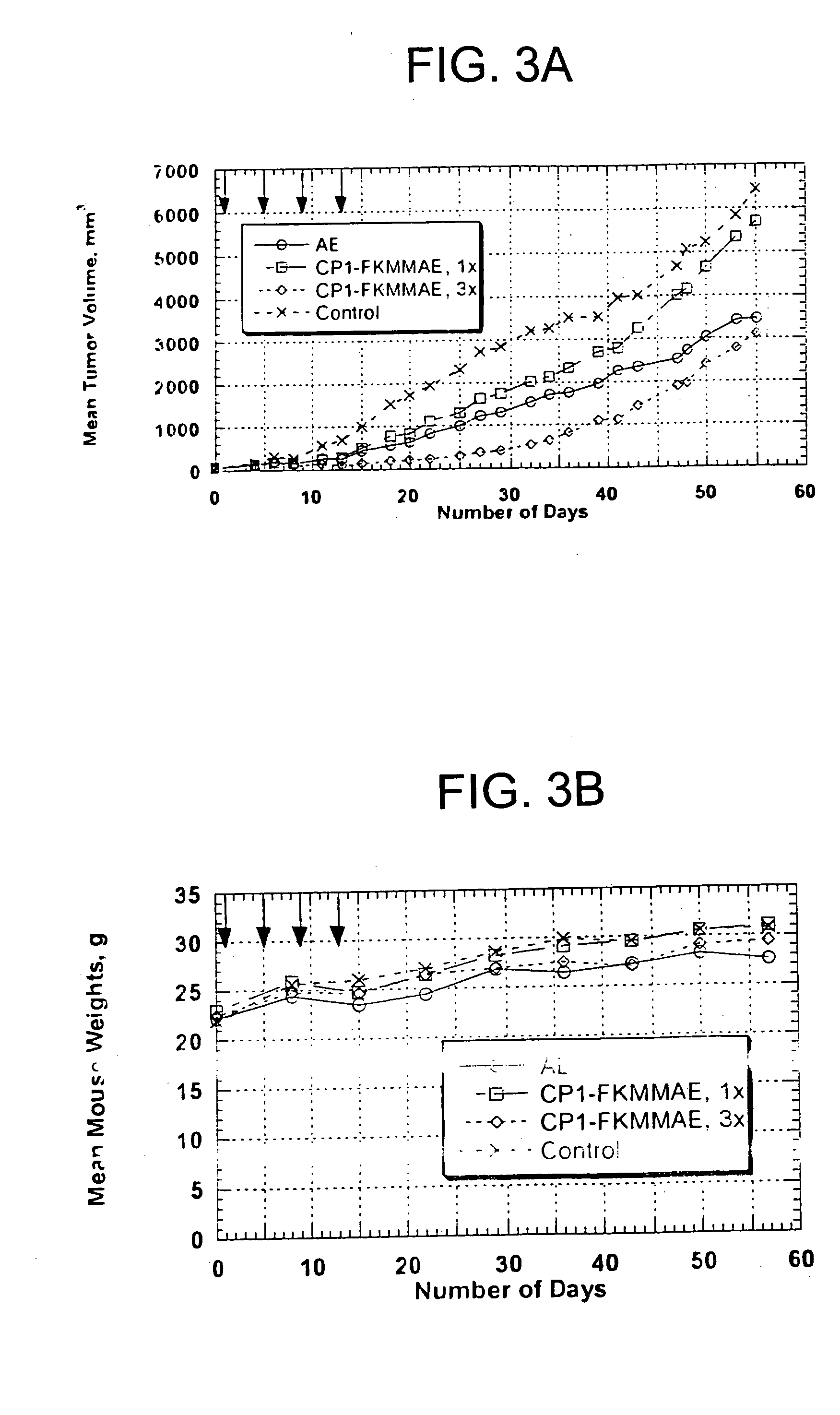Thiol-mediated drug attachment to targeting peptides
a thiol-mediated, drug-like technology, applied in the field of site-specific attachment of drugs to somatostatin peptides, can solve the problems of drug attachment, limited use of peptide analogs in diagnosis and therapy, edman degradation of conjugates, loss of chelating moiety, etc., to improve in vitro and in vivo stability, the effect of reducing the binding to the targ
- Summary
- Abstract
- Description
- Claims
- Application Information
AI Technical Summary
Benefits of technology
Problems solved by technology
Method used
Image
Examples
example 1
Preparation of Peptide Conjugates
[0130] The CP1-AEBL conjugate was prepared using a maleimido derivative of Auristatin E (AEBL) reacted via the thiol of the free cysteine of CP1. The chemistry provides an acid-labile hydrazone linkage that selectively releases AEB, a structural variant of AE having similar potency.
[0131] The CPI-FKMMAE conjugate was prepared using a derivative of AE (FKMMAE) reacted via the thiol of the free CP1 cysteine. The FKMMAE drug structure contains a peptide linkage that is cleaved selectively by the intracellular enzyme cathepsin B. The drug released within the cell is a monomethyl derivative of AE and has potency similar to AE.
[0132] The CP1-chelator conjugate was prepared using a maleimido derivative of MX-DTPA, a high affinity chelator of Indium-111. MEM-MX-DTPA was incubated with CP1 at a 25% molar excess for 1.5 hours at room temperature. pH was neutral upon dilution of reactants with 100 mM phosphate containing 150M NaCl (70%) and DMF (30%). The re...
example 2
Binding Affinity of Peptide Conjugate to Receptor
[0133] Affinity measurements of CP1-AEB binding were determined by performing a competition binding assay. The assay used partially purified membrane extracts from IMR-32 cells, a human neuroblastoma cell line expressing SSTR2. CP1-AEB, CP1 and Octreotide were titrated onto IMR-32 membranes in triplicate dilution tubes arranged in a 96-well plate format. Indium-111-Octreotide competitor was added to IMR-32 membranes, for 1 hour at room temperature in a diluent at neutral pH consisting of 10 mM Hepes, 1 mM MgCl2, 0.3% BSA, and EDTA-free protease inhibitors. IMR-32 membranes were collected under vacuum onto glass fiber filter paper in a 96-well plate format, and membranes were washed four times with 10 mM Tris, 150 mM NaCl, pH 7.5. Captured membranes from each replicate were “punched out” into tubes for counting gamma radioactivity. To estimate an IC50 of Indium-111-Octreotide binding to IMR-32 membranes, recovered radioactivity when u...
example 3
Cellular Uptake of Peptide Conjugates
[0134] SSTR-positive cell lines (human neuroblastoma IMR-32, rat pancreatic carcinoma AR42J) or negative control cells (human colon adenocarcinoma LS174T) were incubated in 6-well plates overnight at 37° C. in a humidified incubator containing 5% C02. Approximately 106 cpm of Indium-111-Octreotide or Indium-111-CP1-MX-DTPA was applied to triplicate wells, in a cocktail containing peptide plus 1000 molar excess somatostatin. Plates were again incubated overnight (20-24 hours) at 37° C. in a humidified incubator containing 5% CO2. Cells were washed with PBS, trypsinized, and collected. Radioactivity present in the cell samples was counted to determine the amount of applied Indium-111-labeled peptide taken up by the cells. Percent uptake of applied cpm was calculated for each triplicate set of wells. Uptake of both peptides was specific, as indicated by the significant reduction in counts in the presence of excess somatostatin (Table 1).
TABLE 1In...
PUM
| Property | Measurement | Unit |
|---|---|---|
| molecular weight | aaaaa | aaaaa |
| affinity | aaaaa | aaaaa |
| stability | aaaaa | aaaaa |
Abstract
Description
Claims
Application Information
 Login to View More
Login to View More - R&D
- Intellectual Property
- Life Sciences
- Materials
- Tech Scout
- Unparalleled Data Quality
- Higher Quality Content
- 60% Fewer Hallucinations
Browse by: Latest US Patents, China's latest patents, Technical Efficacy Thesaurus, Application Domain, Technology Topic, Popular Technical Reports.
© 2025 PatSnap. All rights reserved.Legal|Privacy policy|Modern Slavery Act Transparency Statement|Sitemap|About US| Contact US: help@patsnap.com



